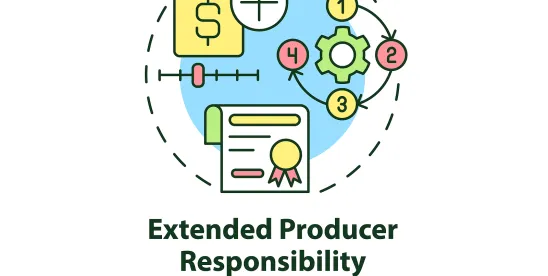2025 has been a busy year for extended producer responsibility (EPR) policy, especially for packaging and paper products. States have enacted new EPR programs and laws to assess the need for EPR. Existing programs have been altered or updated. Compliance deadlines have come and gone. EPR legislation has been introduced in many states. With so many moving parts, the status of EPR in the United States can be hard to follow.
New EPR Laws in 2025
This year, Maryland and Washington became the sixth and seventh states, respectively, to pass legislation to create EPR programs for packaging. Maryland’s SB 901 was signed into law on May 13, 2025. The law uniquely allows multiple Producer Responsibility Organizations (PRO) to operate the program. The EPR law additionally seeks to incentivize use of recyclable, reusable, or compostable packaging. Washington’s EPR bill was signed into law on May 17, 2025. Washington’s EPR program intends to capture consumer packaging products, rather than industrial or commercial packaging. The law will expand collection services to hundreds of thousands of homes not currently served, and over time seeks to reduce consumer recycling bills substantially. Initial compliance deadlines for producers under Washington’s program begin in 2028.
Additional EPR laws have passed in 2025, although these do not establish or create new state programs. Hawaii enacted HB 750, an EPR needs assessment bill, on May 27, 2025. This needs assessment law directs the state’s Department of Health to conduct a scoping study. The outcome of this study is meant to determine what is needed to implement an EPR program to increase recycling, improve collection services, and support material reuse. The assessment is due to the Hawaii legislature by December 31, 2027.
Rhode Island passed a similar needs assessment bill on June 30, 2025, which establishes an implementation analysis for EPR in the state. Maine passed LD 1423 on June 23, 2025. The law amends portions of Maine’s existing EPR law, which became the first of its kind in the United States in 2021. The updated law includes criteria for producer exemptions and modifies certain definitions for clarity. Notably, the amended law revised the definition of “producer.”
Developments under Existing Programs
- In Colorado, Circular Action Alliance (CAA), the PRO operating in the state, was required to submit a draft program proposal by February 1, 2025 (CAA submitted an amended proposal in June 2025). As of July 1, 2025, producers who are not registered and participating in the program are prohibited from selling products within the scope of the program in the state (see page 185 of the adopted Amended Program Plan). CAA is required to report initial data to the state by July 31, 2025, meaning that producers in the state must provide that data to CAA by this deadline.
- Producers who missed Oregon’s initial reporting deadline of March 31, 2025 (included in the approved program plan) were given until April 30, 2025, to provide CAA their reports. CAA proposed to amend Oregon’s program plan in May 2025.
- Maine’s Department of Environmental Protection (MDEP) plans to take steps this year toward selecting a Stewardship Organization (SO) to implement the EPR program. To that end, MDEP published a request for information (RFI) seeking input on “what services the SO must provide” to operate the program, with responses to the RFI due on May 30, 2025.
- Minnesota’s Packaging EPR Advisory Board began meeting in February 2025. CAA’s program plan for the state sought to register all producers subject to the program by July 1, 2025.
- California, which enacted its EPR program on June 30, 2022, is in the process of redrafting regulations under SB 54. These regulations were first drafted in 2024, but the drafting agency (CalRecycle) was directed by Governor Newsom to revisit the regulations to ensure that impacts on industry were adequately considered. A draft of the revised regulations was released on May 16, 2025.
Legislative Developments
- Connecticut’s Substitute for HB 6917, in part, would require a study on the need for EPR for consumer packaging. The bill was tabled on June 4, 2025, for the Senate calendar.
- Illinois introduced companion House and Senate bills for EPR that contain only a short title provision. Both bills were introduced in February 2025, and the last action associated with either bill took place that same month.
- Massachusetts’s EPR bill, S 571, sought to finance recycling infrastructure, increase recycling rates, and eliminate recycling costs for state residents.
- Nebraska’s LB 607 contained in part the EPR Data Collection Act. The EPR portion of the bill would have required producers to provide the state with data on packaging recycling and management. LB 607 would also mandate that certain recycled materials be used in manufacturing processes. The last action related to the bill occurred in February 2025.
- New York saw several bills introduced into its legislature, but only S 1464 (Assembly version A 1749) made significant progress forward. The bill, which eventually stalled on the floor for the session, would have funded the recycling program and would have set limits on certain chemicals contained in packaging, among other things.
- New Jersey’s S 3398 (same as A 5009), introduced in 2024, was considered by Senate and Assembly committees in 2025. The bill would include most types of packaging, and target specifically reductions in single use packaging.
- Tennessee saw the introduction of SB 269 and HB 600, companion bills. These bills, or the Tennessee Waste to Jobs Act, would establish an EPR program, advisory board, periodic need assessments, and more. While these bills did not pass this session, it is the second year in a row that similar legislation has been introduced.
- Minnesota and Oregon also saw the introduction of EPR bills that sought to exempt certain paper products from the respective state programs.
Commentary
Packaging EPR in the United States is here to stay, and the policy is taking hold in new states every year. More and more states are pursuing EPR legislation in the absence of a comprehensive federal program. It is likely that these trends will continue and expand. Producers (or parties who believe they may be producers under these frameworks) should ensure familiarity with existing laws to maintain compliance with new and existing deadlines and help shape emerging programs by participating in the administrative process. With each program differing in scope and application, producers may benefit from seeking legal and policy guidance to ensure a comprehensive understanding of the requirements under respective programs.
Catherina D. Narigon also contributed to this article.



 />i
/>i
